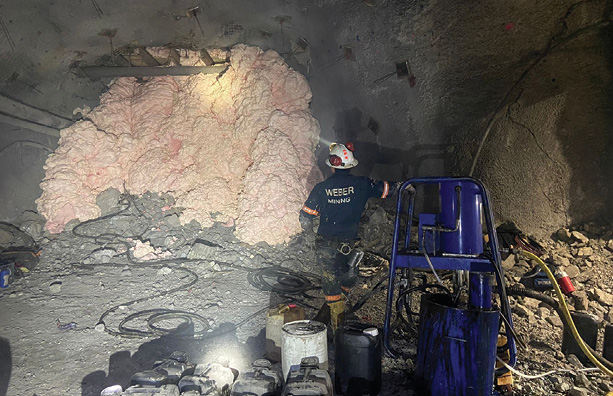Resin injection in ground development

Tunnel development is a main challenge in underground operations. In unstable ground conditions, most fortification methods are applied post-advancement. These traditional methods, such as anchors and mesh, can be limited when the ground is severely altered, and progress cannot be made. The risks of gallery over-excavation and rock bursts are too costly for underground operations. In these conditions, applying a preventive fortification method using resin injection is crucial for safely advancing underground works.
In tunnel development, preventive fortification with resin injection implemented within the mining cycle can increase safety and efficiency within the operation. The fortification is carried out by drilling holes in the front ceiling parallel to the progress. A series of four or five holes (depending on the size of the tunnel) are made to place injection lances and packers in each of them. The lengths of the holes depend on the mine’s progress cycles, generally ranging from five to eight meters. If the resin injection length is six meters, and the mine can progress five meters before repeating the preventive fortification with resin, ensuring that the operators can consistently advance on the consolidated ground.
Once the injection lances and packers are in place, the injection can begin in each hole. The packer in the hole allows it to be pressurized and for the resin to be injected under pressure into the ground. This optimizes the migration of the resin within the ground’s cracks. With a setting time of two minutes, the resin seals the cracks close to the area to be consolidated. This reaction time of the resin not only allows for quick action after injection but also sectorizes the injection. This sectorization ensures the resin is only injected into the area of interest to be consolidated, reducing the amount of product required. In this way, the cost of fortification is reduced, as well as the logistics and time needed to carry it out.
The mechanical properties of the consolidating resins make them ideal as preventive systems. In particular, most resins have a compressive strength greater than 30 MPa. With a bonding strength of 6 MPa and very low viscosity, they have a high capacity to bond and consolidate rock packages when migrating into ground cracks. Additionally, regardless of whether they are injected into constantly stressed ground or in the presence of faults, the resins, being a flexible product, maintain cohesion over time with ground movements. They are also very versatile, as they can be injected into grounds with water or moisture without affecting their mechanical properties. In cases of ground with a high percentage of void, resins that expand 2 to 3 times their initial size can be used, optimizing the filling of ground cracks without greatly increasing the injected amounts or decreasing the fortification’s strength. Finally, once the template of holes is injected, the mine can resume its operation immediately, given the resin’s reaction in just a few minutes, avoiding delays in its operations even in extreme ground situations.
Anthony Ferrenbach is the general manager at Weber Mining Mexico.
Comments